Spotlight
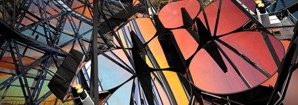
GMT Update from the AAS Meeting
Space.com interviewed Pat McCarthy and Buell Jannuzi at the winter AAS meeting and produced this update on the telescope and mirror-making timescales. First-science, with major amounts of engineering time, might happen as soon as 2023 or 2024. There is a 6 minute computer-generated video (following an advertisement), too. You can read the article HERE.
Photo Credit: Giant Magellan Telescope - GMTO Corporation. Produced by Todd Mason, Mason Media Inc.
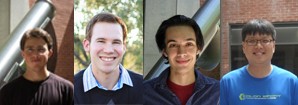
Recent B.S. Degrees and Ph.D. Degrees
We had two astronomy undergrads graduate in December 2016:
Kyle Price-- B.S. Astronomy/Physics (double major)
Michael Evans-- B.A. Journalism (major) Astronomy (minor)
Since the start of summer 2016, the following grad students have gotten PhD's:
Michael Baubock
Nicholas Ballering
Charles Kilpatrick
Youngmin Seo
Congratulations to everyone!
Image: (From left) Baubock, Ballering, Kilpatrick, Seo
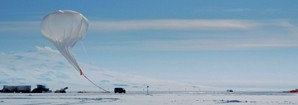
Successful Launch of Stratospheric Terahertz Observatory from Antarctica
Chris Walker's Stratospheric Terahertz Observatory team successfully launched STO from McMurdo in Antarctica on Dec 8, 2016. Photos and Captions are courtesy of Brian Duffy and Chris Walker. They've provided us with several photos. In addition, a video of the launch, provided by collaborator Chris Groppi of ASU, can be seen HERE.
Photo 1, the A-136 STO team. Front Row (L-R) Erin Jacklin, JHUAPL; Brian Duffy, UA; Elliot Rodberg, JHUAPL Back row, standing, (L-R) Christopher Walker, UA; Kay Davis, ASU; William (Bill) Peters, UA; Christopher Groppi, ASU; Abram Young, UA; Michael Carpenter, JHUAPL, Jose Siles, JPL.
Photo 2, Panorama of the Launch. The balloon is an LDB (Long Duration Balloon].
Photo 3, Balloon at moment of release.
Photo 4, Balloon Rising.
Photo 5, Flight Train Approaching Zenith.
Photo 6, STO in Flight.
Photo 7, STO Full Flight Train.
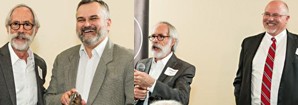
Dennis Zaritsky and Jeff Kingsley Honored by UA
Professor and Deputy Director Dennis Zaritsky and Associate Director Jeff Kingsley have been honored by UA as a 2017 Galileo Circle Fellow and a 2017 Galileo Circle Copernicus Awardee, respectively. "The Galileo Circle Fellows Award is one of the highest honors the College of Science can bestow on its tenure-track faculty. Galileo Circle Fellows are the epitome of the academic scholar, with a deep understanding over a broad range of science, a willingness to think in a truly interdisciplinary way, and an ability to inspire colleagues and students alike." "The Copernicus Award is one of the highest honors the College of Science can bestow on its non-tenure eligible faculty, appointed personnel or classified staff. The awardees' extraordinary accomplishments significantly advance the mission of their department and the knowledge base of their discipline." Congratulations, Dennis and Jeff.
Left: Dean Joaquin Ruiz & Dennis Zaritsky. Right: Dean Ruiz & Jeff Kingsley
Photos Courtesy of COS.

Announcing A New Fellowship at Steward Observatory
We are accepting applications for the first-ever Strittmatter Fellowship at Steward Observatory. It will join our Bok Fellowship, our Prize Fellowship in Theoretical and Computational Astrophysics, and the TAP Fellowship (Theoretical Astrophyics Program, a multi-departmental group) as a named fellowship in Astronomy/Astrophysics at the University of Arizona.
The Strittmatter Fellowship honors Peter Strittmatter, the Director of Steward for 37 years. Information can be found HERE. You can address scientific questions to Dr. Josh Eisner or "how to apply" questions to Elsie Gericke. Evaluation of applications begins Jan. 9, 2017.
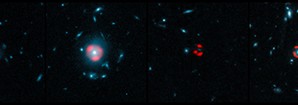
Gravitationally Lensed Dusty Galaxies
[Words by Justin Spilker]
About half of the light from newborn stars is invisible to human eyes - it gets absorbed by interstellar dust between the young star and us, and re-emitted at wavelengths much longer than our eyes can see. Some of the most intense star formation in the history of the universe takes place in galaxies that existed when the universe was about 1/4th of its current age, making new stars hundreds or thousands of times faster than our own Milky Way galaxy does today. These galaxies contain vast amounts of dust, but are extremely faint due to their great distances from us. One way of getting around this problem is to take advantage of a natural phenomenon called gravitational lensing - if there is another galaxy between us and the distant, dusty galaxy we're interested in, the intervening galaxy distorts and magnifies the light of the background galaxy. This makes the background galaxy appear much brighter than it actually is, and allows us to get better spatial resolution images essentially for free, letting us study the dusty galaxies in more detail than otherwise possible.
Steward graduate student Justin Spilker, Steward professor Dan Marrone, and their colleagues used the Atacama Large Millimeter/submillimeter Array (ALMA), a new observatory high in the Chilean Andes, to observe about 50 gravitationally lensed dusty galaxies. ALMA is very sensitive to the re-emitted light coming from dusty galaxies, and uses 66 individual telescope dishes working together to create the highest resolution, most sensitive images ever made at the wavelengths it observes. We used the telescope while it was still under construction, with "only" 14-25 dishes in operation, but this was already enough to make impressive images of our target galaxies. Using an advanced modeling technique to account for the distortions caused by gravitational lensing, we recovered the intrinsic properties of these dusty galaxies, which are magnified by about a factor of 6 on average, and up to a factor of 30. Importantly, we found that there is no noticeable difference between the intrinsic sizes of our lensed galaxies and similar galaxies which are not lensed - in other words, the results are not biased by looking at lensed objects. Lastly, we looked at how the brightness of a spectral emission line of ionized carbon - one of the most important but enigmatic ways for the gas in galaxies to cool - compared across our sample of distant galaxies and very nearby galaxies. The brightness of this line is closely related to the amount of dust emission per unit area (the dust surface brightness). These objects lie on exactly the same relationship as nearby galaxies. Whatever the physics are that drive the emission of this carbon line, it's clear that the compactness of the galaxies plays an important role in setting the relationship.
All four figures show ALMA data in red and HST data in blue. ALMA shows the background galaxies while HST shows the foreground lens galaxies. The three photos not used as the cover photo can be seen HERE, HERE, and HERE.
This research was also featured in the National Radio Astronomy Observatories monthly newsletter.
Photos courtesy of Justin Spilker.
Pages

For Public
Public events include our Monday Night Lecture Series, world-reknowned Astronomy Camp and Mt Lemmon Sky Center.

For Students
A good place to start if you want to become an undergrad major or grad student, or need to find our schedule of classes.

For Scientists
Find telescopes and instruments, telescope time applications, staff and mountain contacts, and faculty and staff scientific interests.




